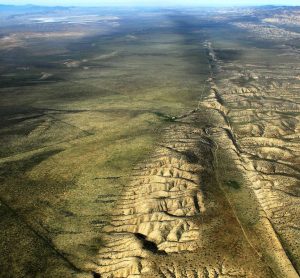Researchers show how a range of fault slip angles explains the observed continuum of earthquake rupture speeds, even those thought forbidden by classic theory.
By Mariah C. Hoskins, Ph.D., Science Writer (@DrMCHoskins)
Citation: Hoskins, M.C., 2021, Fault slip angles reveal continuum of earthquake rupture speeds, Temblor, http://doi.org/10.32858/temblor.153
An earthquake rupture is, in some ways, like tearing a piece of paper, says Jean-Paul Ampuro, a seismologist at the Université Côte d’Azur. The faster you tear, the louder the ripping sound. Likewise, the faster an earthquake ruptures, the more severe the shaking is, he says. Not only is speed a key factor controlling earthquake severity, the size of the ruptured area also matters. Ampuro and other scientists now have an idea of why earthquakes rupture at various speeds, and they presented their findings recently in the journal Nature Geoscience.

Exploring a not-so-forbidden range of rupture speeds
When an earthquake occurs, movement starts at a point on a fault and propagates outward. “What we knew from theory is that earthquakes could be either slow or very fast,” said Ampuro, but a range in the middle was thought impossible. Scientists have puzzled over recent observations of earthquakes rupturing at these so-called “forbidden” speeds. The new study presents an explanation for the continuum of rupture speeds observed in nature and includes two key parameters that were missing from previous models: limited fault depth and oblique slip.

Previous observations of earthquake rupture speed showed that when an earthquake slipped horizontally, a much faster rupture speed was possible than when an earthquake slipped vertically. “Standard” or “classic” earthquake theory, which is based on empirical observations, accounted for this difference in speed potential, but also predicted a range of rupture speeds in the middle that would not be possible. One limitation of classical earthquake theory is that fault slip is simplified to 2D, meaning that scientists could only assume faults slipped either horizontally or vertically when calculating speed.
To understand how rupture speeds in the “forbidden range” occur, Huihui Weng, a seismologist at the Université Côte d’Azur and lead author of the study, said he started “playing around” with computer simulations, introducing oblique slip angles, an element missing from classic models.
A physics-based model
Weng and Ampuro developed a model that predicts rupture speeds observed in natural earthquakes. They account for the physical processes occurring during an earthquake and modeled fault movement in 3D — something not previously done. While classic earthquake theory only considered the end members of vertical or horizontal slip, the new model considers a full range of slip directions. The researchers found that oblique slip is a key factor in earthquakes rupturing in the “forbidden range” of rupture speeds. “Once you have confidence [through validating a model with observations], you can use that model to extrapolate it to all situations that you haven’t seen yet,” Ampuro says, “that’s the use of physics models.”
Additionally, the model shows how the slip angle and the energy buildup on the fault, relate to rupture speed and the potential for very large or “runaway” ruptures.
The beauty of this model is that it is simple, while not being too simple, says Robert Viesca, a seismologist at Tufts University who was not involved in the study. It is useful to have a solid mechanical explanation for why and how different slip speeds occur, says Martin Vallée, a seismologist at Institut de Physique du Globe de Paris who was not involved in the study.
Building block for improving seismic hazard assessment
We rely heavily on models to build frameworks for understanding how earthquakes work, since they occur deep within the earth where we can’t see. This study is a milestone in understanding a range of fast rupturing, potentially damaging earthquakes, says Viesca. These advances in improving the way we understand earthquake rupture can help improve seismic hazard assessment in the future, both Vallée and Viesca said.

Further Reading
Weng, H. & Ampuero, J.P. (2020) Continuum of earthquake rupture speeds enabled by oblique slip. Nature Geoscience, Springer US. doi:10.1038/s41561-020-00654-4
Weng, H. & Ampuro, J.P. (2019) The dynamics of elongated earthquake ruptures. Journal of Geophysical Research, doi.org/10.1029/2019JB017684
- Magnitude 7 Yukon-Alaska earthquake strikes on the recently discovered Connector Fault - December 8, 2025
- Upgrading Tsunami Warning Systems for Faster and More Accurate Alerts - September 26, 2025
- April 2025 magnitude 6.2 earthquake near Istanbul highlights strengths and weaknesses in seismic mitigation - September 14, 2025
